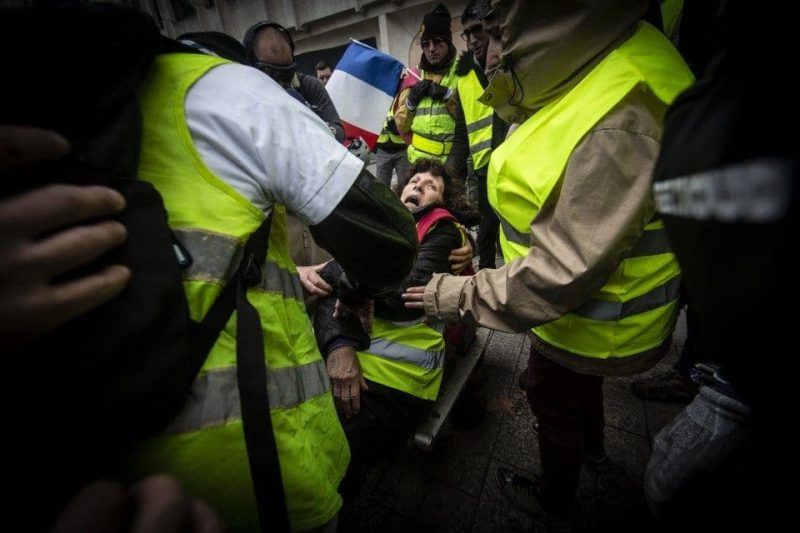
The “gilets jaunes,” or yellow vests, protests in France caught everyone by surprise. Triggered by a proposed increase in the tax on fuel, the protests spread across the country with unprecedented speed and intensity, turning them into an existential threat to President Emmanuel Macron’s political project.
The press has emphasized social media’s role in enabling the protests to grow and spread without any central organization. Social media is getting the credit for allowing far-flung individuals to coordinate, drawing participants from many backgrounds and remote corners of the country, making preemptive police action difficult. Social media also has gotten the credit for other incidents of mass unrest in recent history, including the Arab Spring and the 2011 London riots.
But is all this really new? Have we never before seen a leaderless mass movement, joined by people from all walks of life with different priorities and no coherent political project? My work on the Swing riots, the largest rural uprising in 19th-century England, suggests it is not new.
Let’s look at the 19th-century Swing riots in England
The Swing riots, also known as the Great English Agricultural Uprising of 1830, took place in the winter of 1830-31 and spread throughout the cereal-growing areas in the south and east of England. Landless farm laborers who lived in extreme poverty demanded economic changes: higher wages, more generous welfare payments and more work. The unrest lasted for 40 weeks, and records show nearly 3,000 Swing-related events involving thousands of people. The rioters targeted local landlords with vandalism and arson, destroying new farming machinery.
Many of the participants were executed, imprisoned or deported. Nevertheless, the riots led to the Great Reform Act, a significant change in Britain’s electoral institutions and an expansion of who could vote. The riots have also been linked to the birth of Chartism, a movement that sought to bring the vote to the masses. Their importance to democratic changes made the Swing riots the topic of some of the first studies in social history.
Both the yellow vests movement and the Swing protests grew from deep economic grievances. For the Swing rioters, the key factors seem to have been extreme poverty, a number of bad harvests and technological change that had thrown many of them out of work. For the yellow vests, Macron’s proposed fuel tax was interpreted as the latest signal that official economic policy cared little about ordinary people and favored the rich. And just as the Swing riots arose in a time of political upheaval in Europe, the yellow vests are protesting at a time when many Europeans are voting for far-right parties, angry that their countries and institutions are leaving them behind.
The Swing riots and the “gilets jaunes” protests share a striking number of features. Both were decentralized uprisings with no clear leaders. In both, organized groups unsuccessfully tried to hijack the protests — in the Swing riots, radicals tried to turn the movement into a revolutionary one; among the yellow vests, right-wing leader Marine Le Pen has attempted to use the protests to further her political agenda.
And in both, protesters had a variety of specific grievances but no coherent political agenda. Like the yellow vests protests, the Swing riots initially spread because the authorities did not fully grasp the extent of the unrest, so there was little repression at the start. Similarly, in France, Macron appears to have underestimated the extent of the grievances against his government.
Although many suspected that the Swing riots were part of a national conspiracy, historians have been unable to unearth any evidence that they were centrally organized. Using the date and specific geographic location of nearly 3,000 Swing-related incidents, coupled with data on local political organization, we have confirmed this: The Swing riots appear to have spread spontaneously through word of mouth among landless farm laborers who interacted locally or at fairs and coach stops. Among the “gilets jaunes,” social media may be spreading the word in a similar way.
Of course, the two protest movements are quite different in many ways
Naturally, there are considerable differences between the Swing riots and the “gilets jaunes.” Today’s law enforcement is far more effective. A large and well-equipped police force — something that did not exist in 1830s England — can limit any movement. The large deployment of police and armed vehicles in France over the weekend, coupled with a large number of arrests, helped control the unrest.
But the flip side is also true: Current French political institutions are designed to listen to the poor and disadvantaged far more than English institutions were in the 1830s. The vast majority of Swing rioters did not have the right to vote and could not read or write. Yet their uprising led to changes that in time would give them full political rights.
Can the Swing riots help us understand what will happen next in France?
As happened in France this weekend, repression of the Swing movement intensified once the British government realized the extent of the unrest and that it might lead to revolution. This, together with the exhaustion of possible targets and the arrival of spring and summer agricultural jobs, brought the riots to an end in early 1831.
But at a time when revolution was roiling Europe and industrialization had made existing institutions obsolete, the rioters prompted British leaders to reform the country’s political institutions to avoid further unrest. The Swing movement, in other words, prompted changes that probably helped avert revolution in Britain.
Revolutionary fervor is again sweeping Europe. The “gilets jaunes” protests are just another sign that as the global economy is transforming, French and European institutions face serious pressure to adapt.
Gabriel Leon (@gabrieljleon) is a senior lecturer in political economy at King’s College London.
